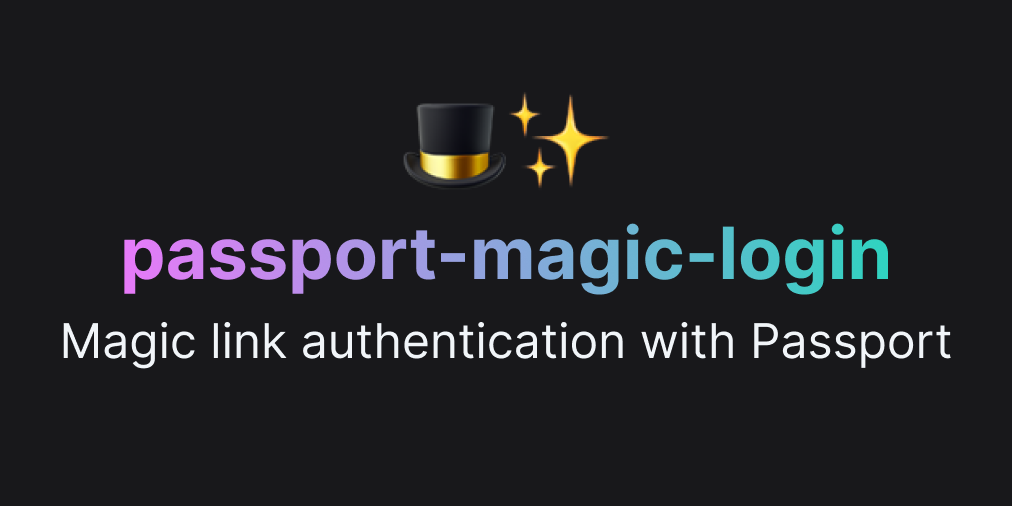Passwordless authentication with magic links for Passport.js 🔑
- User signup and login without passwords
- Supports magic links sent via email, SMS or any other method you prefer
- Create magic links in code for inclusion in your own methods and pipelines
- User interface agnostic: all you need is an input and a confirmation screen
- Handles secure token generation, expiration and confirmation
Originally implemented by Tobias Lins for Splitbee and extracted for Feedback Fish, with further development by Neil Rackett for Mesmotronic
To use magic link authentication, you can:
- Setup the Passport strategy and Express routes on your server
- POST a request with the user's email or phone number from the client once they have entered it into the login input; or
- Generate a magic link in code and include it in your own method
npm install @mesmotronic/passport-magic-login
This is what the usage from the frontend might look like once you've set it all up. It only requires a single request:
// POST a request with the users email or phone number to the server
fetch(`/auth/magiclogin`, {
method: `POST`,
body: JSON.stringify({
// `destination` is required.
destination: email,
// However, you can POST anything in your payload and it will show up in your verify() method
name: name,
}),
headers: { 'Content-Type': 'application/json' }
})
.then(res => res.json())
.then(json => {
if (json.success) {
// The request successfully completed and the email to the user with the
// magic login link was sent!
// You can now prompt the user to click on the link in their email
// We recommend you display json.code in the UI (!) so the user can verify
// that they're clicking on the link for their _current_ login attempt
document.body.innerText = json.code
}
})To make this work so easily, you first need to setup passport-magic-login:
import MagicLoginStrategy from "passport-magic-login"
// IMPORTANT: ALL OPTIONS ARE REQUIRED!
const magicLogin = new MagicLoginStrategy({
// Used to encrypt the authentication token. Needs to be long, unique and (duh) secret.
secret: process.env.MAGIC_LINK_SECRET,
// The authentication callback URL
callbackUrl: "/auth/magiclogin/callback",
// Called with the generated magic link so you can send it to the user
// "destination" is what you POST-ed from the client
// "href" is your confirmUrl with the confirmation token,
// for example "/auth/magiclogin/confirm?token=<longtoken>"
sendMagicLink: async (destination, href) => {
await sendEmail({
to: destination,
body: `Click this link to finish logging in: https://yourcompany.com${href}`
})
},
// Once the user clicks on the magic link and verifies their login attempt,
// you have to match their email to a user record in the database.
// If it doesn't exist yet they are trying to sign up so you have to create a new one.
// "payload" contains { "destination": "email" }
// In standard passport fashion, call callback with the error as the first argument (if there was one)
// and the user data as the second argument!
verify: (payload, callback) => {
// Get or create a user with the provided email from the database
getOrCreateUserWithEmail(payload.destination)
.then(user => {
callback(null, user)
})
.catch(err => {
callback(err)
})
}
// Optional: options passed to the jwt.sign call (https://github.com/auth0/node-jsonwebtoken#jwtsignpayload-secretorprivatekey-options-callback)
jwtOptions: {
expiresIn: "2 days",
}
})
// Add the passport-magic-login strategy to Passport
passport.use(magicLogin)Once you've got that, you'll then need to add a couple of routes to your Express server:
// This is where we POST to from the frontend
app.post("/auth/magiclogin", magicLogin.send);
// The standard passport callback setup
app.get(magicLogin.callbackUrl, passport.authenticate("magiclogin"));That's it, you're ready to authenticate! 🎉
If you need to create a magic link without POSTing data to the API you can use the create method, for example:
const sendCustomerNotification = async (destination: string) => {
// The `create` method generates a magic link for the specified destination (email)
// and returns a URL and verification code
const { href, code } = magicLogin.create(destination);
await sendEmail({
to: destination,
body: `You have a new document! Click this link to login: https://yourcompany.com${href} (verification code ${code})`
});
};
sendCustomerNotification('customer@email.address');Licensed under the MIT license. See LICENSE for more information!
